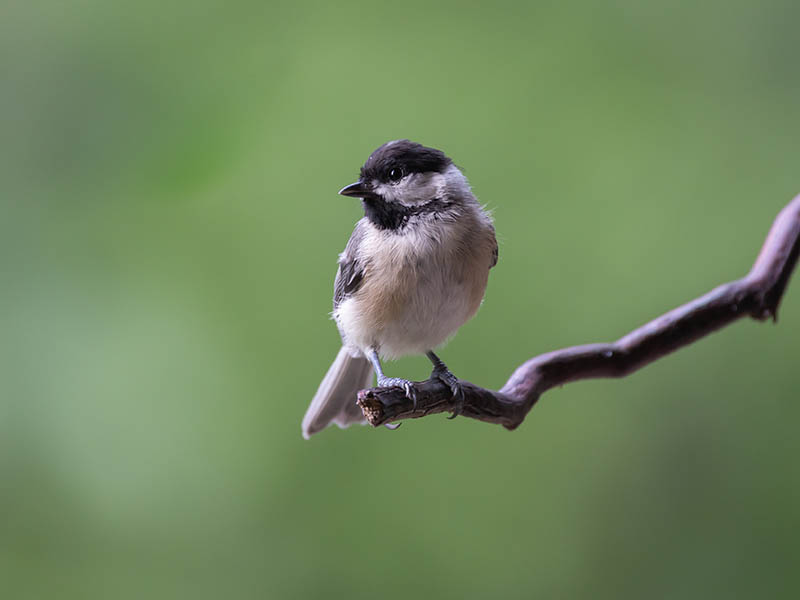Mexican Chickadee: Field Guide, Pictures, Habitat & Info
Last Updated on

The chickadee is a well-loved and beautiful songbird that comes in many different variations. One that you might’ve heard of is the Mexican Chickadee. But what does the Mexican Chickadee look like, where do they live, and how can you spot them?
We break it all down for you here!

Quick Facts About the Mexican Chickadee
| Habitat: | High mountain fir forests and oak woodlands |
| Diet: | Mostly insects and a few types of seeds |
| Behavior: | Active foragers, monogamous mating, and vocal |
| Nesting: | In holes between 10’ and 40’ above ground |
| Conservation: | IUCN Least Concern |
| Scientific name: | Poecile sclateri |
| Lifespan: | 3 to 7 years |
Mexican Chickadee General Description
The Mexican Chickadee is a small songbird with an extremely limited range in parts of Mexico. But they’re not endangered, and due to their small size and active lifestyle, they’re a favorite among bird watchers everywhere.
They have black-and-white heads with a pointed beak, and their body is mostly gray feathers. They don’t stand out that much, but if you get a good look at these birds, it’s hard to describe them as anything other than adorable.

Mexican Chickadee Range, Habitat, Behavior, Diet & Nesting
Range
The Mexican Chickadee has an extremely limited range throughout portions of forested areas in Mexico. They live primarily in the lower regions of the state and along a strip of forest on the western side of the country.
These small songbirds will sometimes make their way into the southernmost tips of Arizona and New Mexico. But keep in mind that it’s only along a small portion of the southernmost areas of both these American states. If you’re unwilling to travel to Mexico but want to spot these birds, these are your only two options!
Habitat
If you want to spot a Mexican Chickadee, you’ll need to travel to a mature forest. Not every type of forest will do. While you can occasionally spot these birds in oak woodlands, they typically prefer fir forests in mountainous regions.
Even when you’re in these forests, you’ll need to look up toward the tree tops if you’re trying to spot these birds!
Behavior
The Mexican Chickadee is an extremely active small bird. They zip around from place to place all day, and they’ll make several song chirps.
They are monogamous birds, preferring to stick with the same partner over several seasons if they can.
Diet
Since these birds mostly eat insects, they’re active throughout most of the day. They fly from place to place to try to eat different insects and will typically feed in an upside-down position on trees.
While it’s suspected that these birds will eat seeds occasionally during the leaner winter months, that’s not completely confirmed.
Nesting
If you’re looking to spot a Mexican Chickadee nest, you’ll need to look up. The birds make use of natural holes in trees from either the way the wood grew or from a woodpecker to build their nests.
While you can sometimes find their nests closer to the ground, if they have the option, they’ll build their nest at least 10’ off the ground. But they’ll happily climb as high as 40’ to build their nests.

How to Find Mexican Chickadees: Birdwatching Tips
What to Listen For
With a few different songs, it can sometimes be a challenge to realize that you’re hearing a Mexican Chickadee. Most of their songs involve a quick chirp followed by some sort of recurring clicking sound, but that doesn’t describe every song that they can produce.
What to Look For
If you’re trying to spot a Mexican Chickadee, it’s best to find their nests. They nest high up in trees in holes, so look for old woodpecker locations. If a hole is there, there’s a good chance that a Mexican Chickadee is making their home there.
When to Look
Since the Mexican Chickadee is most active during the day, this is when you want to start your search. You should be able to look up and see them flying from location to location looking for something to eat.
Attracting Mexican Chickadees to Your Backyard: Tips & Tricks
Even if you’re lucky enough to live in the Mexican Chickadee’s range, there’s not much that you can do to try to attract them to your yard. You need mature trees that stand at least 20’ tall, and that’s not something that you can put up overnight.
However, if you already have those trees, you can try to attract other birds like woodpeckers first. Once they create a hole in a tree, it’s only a matter of time until a Mexican Chickadee comes and makes a nest there.

Mexican Chickadee Conservation: Is this Bird Threatened?
Despite the extremely limited range of the Mexican Chickadee, the IUCN has it under the category of “Least Concern.” That means there are currently no imminent threats to the Mexican Chickadee.
In fact, the Mexican Chickadee is thriving, with an estimated population of about 2 million birds.

Final Thoughts
While the Mexican Chickadee might have a limited range, they’re an extremely nimble, quick, and interesting songbird that is a favorite of many birders.
Now that you know more about them, it’s up to you if you want to try to spot one for yourself or track down another Chickadee variant!
Featured Image Credit: J K Laws, Shutterstock
Table of Contents
- Quick Facts About the Mexican Chickadee
- Mexican Chickadee General Description
- Mexican Chickadee Range, Habitat, Behavior, Diet & Nesting
- How to Find Mexican Chickadees: Birdwatching Tips
- Attracting Mexican Chickadees to Your Backyard: Tips & Tricks
- Mexican Chickadee Conservation: Is this Bird Threatened?
- Final Thoughts
About the Author Robert Sparks
Robert’s obsession with all things optical started early in life, when his optician father would bring home prototypes for Robert to play with. Nowadays, Robert is dedicated to helping others find the right optics for their needs. His hobbies include astronomy, astrophysics, and model building. Originally from Newark, NJ, he resides in Santa Fe, New Mexico, where the nighttime skies are filled with glittering stars.
Related Articles:
10 Types of Hummingbirds in Arkansas (With Pictures)
8 Types of Hummingbirds in Nebraska (With Pictures)
5 Types of Hummingbirds in Idaho (With Pictures)
3 Types of Hummingbirds in Mississippi (With Pictures)
8 Types of Hummingbirds in Kansas (With Pictures)
5 Types of Hummingbirds in West Virginia (With Pictures)
5 Types of Hummingbirds in Ohio (With Pictures)
Where Do Nuthatches Nest? Nuthatch Nesting Habits Explained
